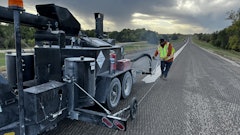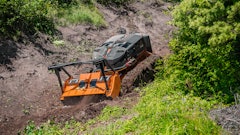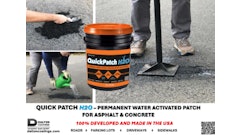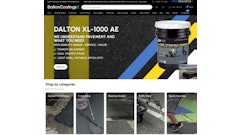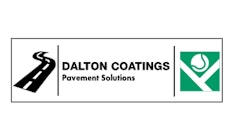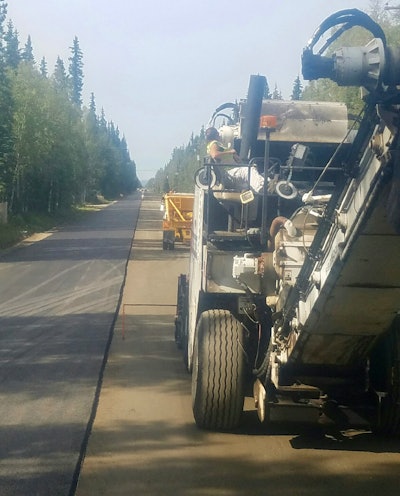
Sometimes it’s the paving that creates the challenge for contractors, but oftentimes it’s the location – and the accompanying vehicle and pedestrian traffic – that can make a straightforward job difficult.
That was the case when Exclusive Paving, North Pole, AK, won the bid to upgrade and widen 3-mile-long Goldhill Road, a pavement that had been reconstructed and chip sealed in 1976 and that today gathers pedestrian and auto traffic from numerous roads in a residential community. The job went so well that Exclusive Paving, Fairbanks, was recognized with a Quality in Construction Award by the National Asphalt Pavement Association.
In business for 30 years as a general contractor, Exclusive Paving primarily produces hot mix asphalt, ready mix concrete, and aggregate, according to Jeff Galterio, general manager. The contractor, a division of Colaska, a subsidiary of Colas U.S., employs 100 people when going “full bore,” as Galterio says, generating at least 50% of its sales annually from paving. He says the contractor does some commercial work but work for cities, the state of Alaska and military bases is what keeps the company busy.
The challenge of Goldhill Road was a challenge many communities face. When the road was constructed the population density was lighter, but as density increased in the residential area the road became much more heavily travelled. In addition, as more people moved to the area, jogging, bicycling and walking became more common, with Goldhill Road receiving much of this recreational traffic. Unfortunately, the road was narrow and ditches on each side meant recreational enthusiasts had to battle with traffic. So safety became a major concern.
“The road before this job was fairly narrow, just two drive lanes and no shoulder,” Galterio says. “It went through a primarily residential area with a lot of streets extending off of it which generated a lot of bicyclists and joggers and walkers on the route with little room for them.”
So there was a push from the community to make the road more pedestrian and bike friendly. And because there were ditches and limited right-of-way along the road there wasn’t enough room to construct a separate bike path.
Creating Space for Added Width
Galterio says the entire route was fairly narrow, so Exclusive Paving started the job doing a fair amount of clearing brush and cutting down some trees to open up space to add 4 ft. of paved shoulder on each side of the road.
He says the existing subbase was constructed primarily of mine tailings which contained rock chunks as large 10-12-in. The chip seal surface was ground in place, and crews excavated damaged areas, removing asphalt patches up to 1 ft. deep and areas with the large stone, then filled in the excavated areas.
“After the road was ground in place, we used dozers to cut and build the embankments and graders to establish the designed subgrade profile,” Galterio says.
Exclusive Paving anticipated that the widening of the roadway could be completed by balancing the existing subgrade in place to meet the new roadway profile, but they later determined they needed additional material trucked in to balance the cuts and fills to achieve the additional width. Galterio says the company used two crews and coordinated with Alaska DOT to allow continuous traffic flow while maintaining even lanes of travel at the end of each shift.
Then Exclusive Paving brought in 6 in. of subbase.
“The new 6-in. subbase was pretty loose and there was a lot of traffic on that road even when we were doing the reconstruction,” Galterio says. “We weren’t happy with how the new specified sub base was holding up to traffic and it certainly was not going to provide an adequate paving surface, so we talked with the state. They agreed that placing a 2 in. layer of D-1 on top of the subbase would go a long way to strengthening the road structure, making it safer for drivers passing through the work zone, and providing a much more stable base for the paving.”
Use of the D-1 asphalt treated base created some delays as it required a change order, and work had to be reconfigured so that at the end of each shift the looser subbase was capped with D-1 and ready to accept traffic so drivers wouldn’t get stuck the next morning.
When it came time to pave the 11-ft.-wide road with 4-ft. shoulders on each side Exclusive Paving paved one lane in one direction from start to finish, then turned around and paved the same distance in the other direction, completing the paving with only one seam down the middle. The same process was used for both the asphalt treated base and the 2-in. top course.
Controlling Traffic
“The toughest thing about the job was dealing with a lot of traffic, with everybody going to work in the morning and everybody coming home in the early evening,” he says.
To minimize the impact on drivers, crews didn’t start work until after residents went to work. And once work was underway Exclusive Paving used its pilot cars to get people through the work site as quickly and safely as possible.
“This is a challenge that comes with just about any project but the density of the residential population and the fact that there wasn’t another route made the traffic control and safety of the pedestrians especially important,” Galterio says.
Intersection Improvement
In addition to widening Goldhill Road to accommodate bikers and joggers more safely, the award-winning project also called for a realignment to increase the sight distance at a major intersection at the end of the roadway. Excavation in this area revealed discontinuous permafrost which required a redesign by the DOT and a substantial change order.
Jeff Galterio says the new alignment was excavated 6 ft. to the top of permafrost and built back up with 8 in. of expanded polystyrene foam, three layers of woven geotextile, and non-frost susceptible gravel material.
“We brought in a separate crew to do the work once the change order was approved so the change didn’t delay the project,” Galterio says. “Otherwise it would have added as much as two weeks to the job.”
[possible captions]
Exclusive Paving’s HMA plant runs from about May 15-October 15. “We go as fast as we can for as long as we can,” says Jeff Galterio. “By Halloween we usually have snow on the ground that’s going to stick.”
“The original road was cut with dozers and we used the extra material as fill along the side,” Galterio says.
“It was a challenge because the material was boney with big rocks,” Galterio says. “We excavated the rocks and damages areas and used the material to the fill ditch lines along the side.”
The 1-in. chip seal pavement was ground in place and asphalt patches were removed up to 1 ft. deep.
“We were able to minimize the impact of change orders and traffic control on the schedule, which was very important because the job was running into the end of our season,” Jeff Galterio says. “We were running up against the end of the paving and striping window at the end of the season.”





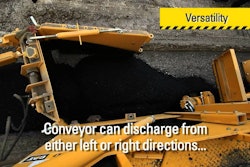






![Lee Boy Facility 2025 17 Use[16]](https://img.forconstructionpros.com/mindful/acbm/workspaces/default/uploads/2025/09/leeboy-facility-2025-17-use16.AbONDzEzbV.jpg?ar=16%3A9&auto=format%2Ccompress&fit=crop&h=135&q=70&w=240)

